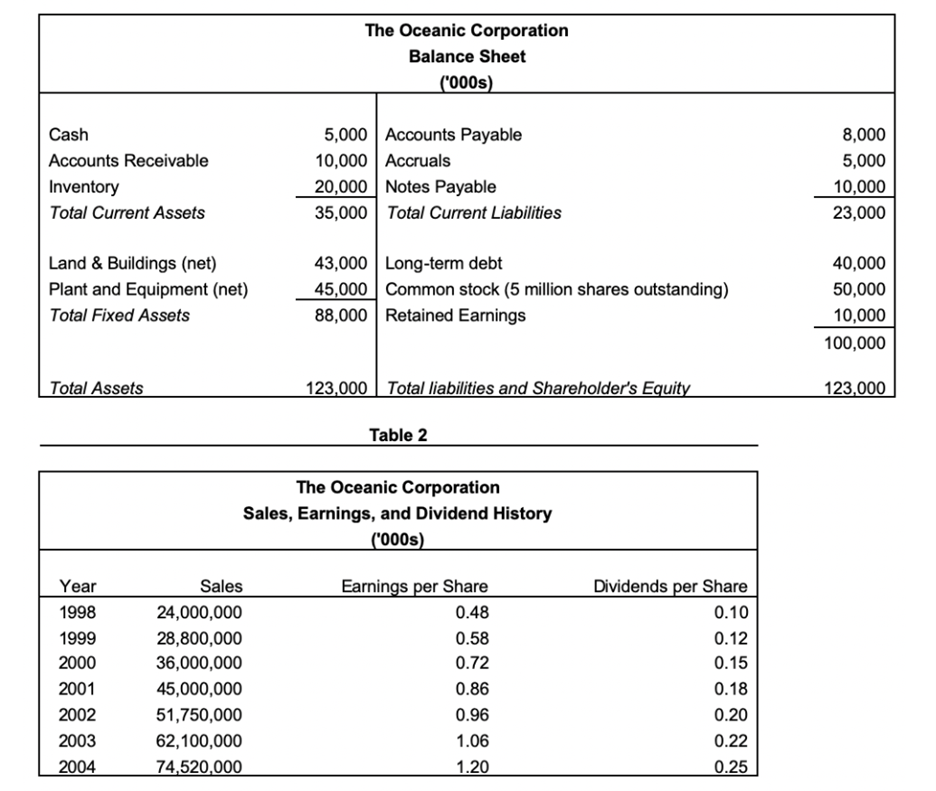The Oceanic Corporation, a Chesapeake, VA based company, was established in 1994. Glenn Rodgers III founded the corporation, which was privately owned at the time, after his retirement from Norentech Corporation. The Oceanic Corporation was originally formed to provide ship repair services and quickly earned a Department of Defense (DOD) certified Alteration Boat Repair (ABR) designation. Among its specialties were structural welding, piping system installation and repairs, custom sheet metal fabrication. Other divisions of The Oceanic included Habitability Installation, Industrial Contracting, and Alteration/Installation Teams (AIT). With its initial success and good return on investment the firm opened and operated facilities in California, New Jersey, Florida, Maryland, Pennsylvania and Washington. In 1998, the company went public and its initial public offering was very successful. The stock price had risen from its initial value of $10 to its current level of $35 per share. There were currently 5 million shares outstanding. In 1999, the company issued 30-year bonds at par with a face value of $1000 and a coupon rate of 10% per year, and managed to raise $40 million for expansion. Currently, the AA rated bonds had 25 years left until maturity and were being quoted at 91.15% of par.
The Oceanic Corporation, a Chesapeake, VA based company, was established in 1994. Glenn Rodgers III founded the corporation, which was privately owned at the time, after his retirement from Norentech Corporation.
The Oceanic Corporation was originally formed to provide ship repair services and quickly earned a Department of Defense (DOD) certified Alteration Boat Repair (ABR) designation. Among its specialties were structural welding, piping system installation and repairs, custom sheet metal fabrication. Other divisions of The Oceanic included Habitability Installation, Industrial Contracting, and Alteration/Installation Teams (AIT). With its initial success and good return on investment the firm opened and operated facilities in California, New Jersey, Florida, Maryland, Pennsylvania and Washington.
In 1998, the company went public and its initial public offering was very successful. The stock price had risen from its initial value of $10 to its current level of $35 per share. There were currently 5 million shares outstanding. In 1999, the company issued 30-year bonds at par with a face value of $1000 and a coupon rate of 10% per year, and managed to raise $40 million for expansion. Currently, the AA rated bonds had 25 years left until maturity and were being quoted at 91.15% of par.
Over the past year, The Oceanic Corporation utilized a new method for fabricating composite materials that the firm’s engineers had developed. In June of last year, management established the Advanced Materials Group (AM Group), which was dedicated to pursuing this technology. The firm recruited Larry Stone, a senior engineer, to head the AM Group. Larry also had an MBA from a prestigious university under his belt.
Upon joining Oceanic, Larry realized that most projects were being approved on a “gut feel” approach. There were no formal acceptance criteria in place. Up until then, the company had been lucky in that most of its projects had been well selected and it had benefited from good relationships with clients and suppliers. “This has to change,” said Larry to his assistant Stephanie, “we can’t possibly be this lucky forever. We need to calculate the firm’s hurdle rate and use it in future.” Stephanie Phillips, who had great admiration for her boss, replied, “Yes, Larry, why don’t I crunch out the numbers and give them to you within the next couple of days?” “That sounds great, Stephanie,” said Larry. “My years of experience tell me that when it comes to the hurdle rate for new projects, one size hardly ever fits all!”
As Stephanie began looking at the financial statements, she realized that she was going to have to make some assumptions. First, she assumed that new debt would cost about the same as the yield on outstanding debt and would have the same rating. Second, she assumed that the firm would continue raising capital for future projects by using the same target proportions as determined by the book values of debt and equity (see Table 1 for recent balance sheet). Third, she assumed that the equity beta (1.5) would be the same for all the divisions. Fourth, she assumed that the growth rates of earnings and dividends would continue at their historical rate (see Table 2 for earnings and dividend history). Fifth, she assumed that the corporate tax rate would be 34%, and finally, she assumed that the flotation cost for debt would be 5% of the issue price and that for equity would be 10% of selling price. The 1-year treasury bill yield was 4% and the expected
ASSIGNMENT: CALCULATE THE FIRM'S COST OF DEBT

Trending now
This is a popular solution!
Step by step
Solved in 3 steps with 4 images







